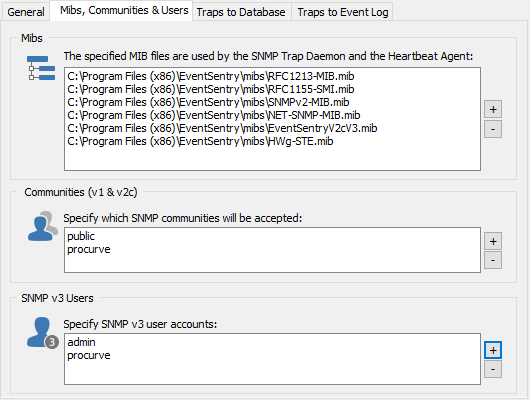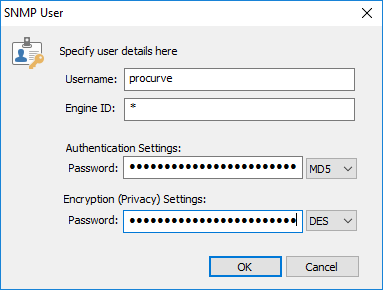The "Mibs, Communities & Users" tab configures which MIB files to load, which communities to accept and also configures SNMP v3 users.

|
All fields can be double-clicked to edit existing values. |
Mibs
In order for OIDs to be interpreted correctly, MIBs that match the received traps will need to be configured. Which MIBs to load depends from which devices the daemon will be receiving traps from. Standard MIBs can be downloaded from the Internet, whereas vendor-specific MIBs are usually obtained from the vendor, e.g. the vendor's web site.
You can specify up to 128 MIB files, multiple MIB files can be selected when adding MIBs.
Make sure that any MIB files added are located on a physical drive, and not a network drive, and that the account the "Network Services" service is running under ("LocalSystem" by default) has permissions to read the file(s).
Communities
SNMP v1 and v2c traps use community names for authentication; specify community names for which traps should be accepted here. Traps using a community name that is not listed will be silently discarded.
SNMP v3 Users
Incoming v3 traps need to be authenticated in order to be accepted.
|
SNMP v3 users support the following properties:
- Username (required) - EngineID (optional, a usually unique identifier from the network device) - Authentication password and algorithm - Encryption password and algorithm
Authentication and Encryption When transmitting SNMP v3 traps over a network, you can choose to authenticate to ensure authenticity of the sender, and/or encrypt the trap to ensure that the contents of the trap are not visible to a third party. Encrypting traps is particularly important when transmitting traps over an insecure media like the Internet. The following authentication and encryption algorithms are currently supported:
Authentication: MD5, SHA Encryption: DES, AES, 3DES |

